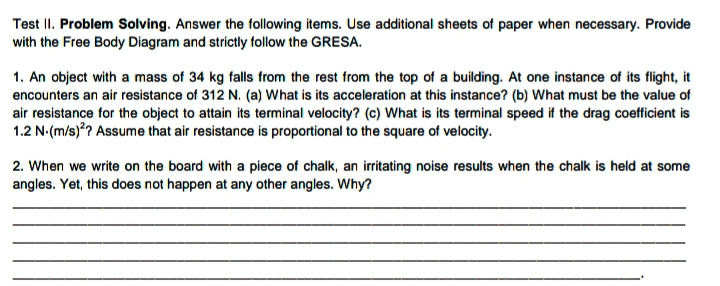Test II. Problem Solving. Answer the following items. Use additional sheets of paper when necessary. Provide with the Free Body Diagram and strictly follow the GRESA. 1. An object with a mass of 34 kg falls from the rest from the top of a building. At one instance of its flight, it encounters an air resistance of 312 N. (a) What is its acceleration at this instance? (b) What must be the value of air resistance for the object to attain its terminal velocity? (c) What is its terminal speed if the drag coefficient is 1.2 N-(m/s)?? Assume that air resistance is proportional to the square of velocity.
Test II. Problem Solving. Answer the following items. Use additional sheets of paper when necessary. Provide with the Free Body Diagram and strictly follow the GRESA. 1. An object with a mass of 34 kg falls from the rest from the top of a building. At one instance of its flight, it encounters an air resistance of 312 N. (a) What is its acceleration at this instance? (b) What must be the value of air resistance for the object to attain its terminal velocity? (c) What is its terminal speed if the drag coefficient is 1.2 N-(m/s)?? Assume that air resistance is proportional to the square of velocity.
College Physics
1st Edition
ISBN:9781938168000
Author:Paul Peter Urone, Roger Hinrichs
Publisher:Paul Peter Urone, Roger Hinrichs
Chapter4: Dynamics: Force And Newton's Laws Of Motion
Section: Chapter Questions
Problem 24PE: The wheels of a midsize car exert a force of 2100 N backward on the road to accelerate the car in...
Related questions
Topic Video
Question
Pa answer po please.

Transcribed Image Text:Test II. Problem Solving. Answer the following items. Use additional sheets of paper when necessary. Provide
with the Free Body Diagram and strictly follow the GRESA.
1. An object with a mass of 34 kg falls from the rest from the top of a building. At one instance of its flight, it
encounters an air resistance of 312 N. (a) What is its acceleration at this instance? (b) What must be the value of
air resistance for the object to attain its terminal velocity? (c) What is its terminal speed if the drag coefficient is
1.2 N-(m/s)*? Assume that air resistance is proportional to the square of velocity.
2. When we write on the board with a piece of chalk, an irritating noise results when the chalk is held at some
angles. Yet, this does not happen at any other angles. Why?
Expert Solution
This question has been solved!
Explore an expertly crafted, step-by-step solution for a thorough understanding of key concepts.
Step by step
Solved in 3 steps with 2 images

Knowledge Booster
Learn more about
Need a deep-dive on the concept behind this application? Look no further. Learn more about this topic, physics and related others by exploring similar questions and additional content below.Recommended textbooks for you

College Physics
Physics
ISBN:
9781938168000
Author:
Paul Peter Urone, Roger Hinrichs
Publisher:
OpenStax College

Glencoe Physics: Principles and Problems, Student…
Physics
ISBN:
9780078807213
Author:
Paul W. Zitzewitz
Publisher:
Glencoe/McGraw-Hill

University Physics Volume 1
Physics
ISBN:
9781938168277
Author:
William Moebs, Samuel J. Ling, Jeff Sanny
Publisher:
OpenStax - Rice University

College Physics
Physics
ISBN:
9781938168000
Author:
Paul Peter Urone, Roger Hinrichs
Publisher:
OpenStax College

Glencoe Physics: Principles and Problems, Student…
Physics
ISBN:
9780078807213
Author:
Paul W. Zitzewitz
Publisher:
Glencoe/McGraw-Hill

University Physics Volume 1
Physics
ISBN:
9781938168277
Author:
William Moebs, Samuel J. Ling, Jeff Sanny
Publisher:
OpenStax - Rice University
